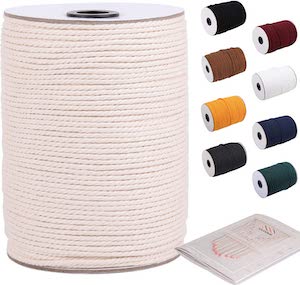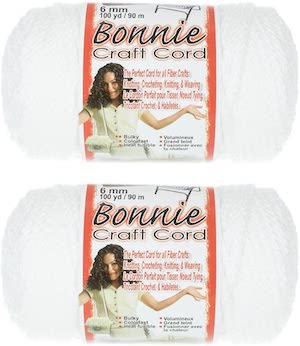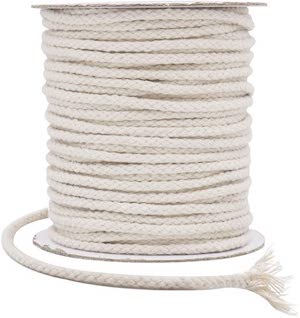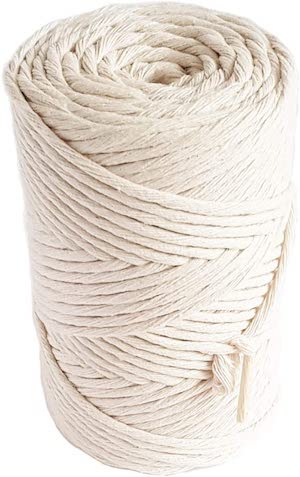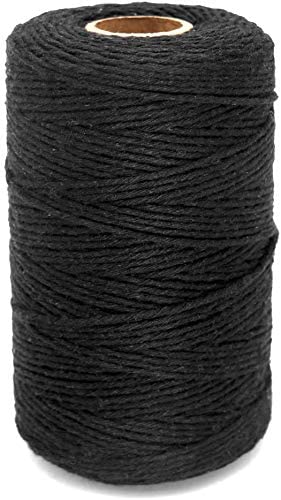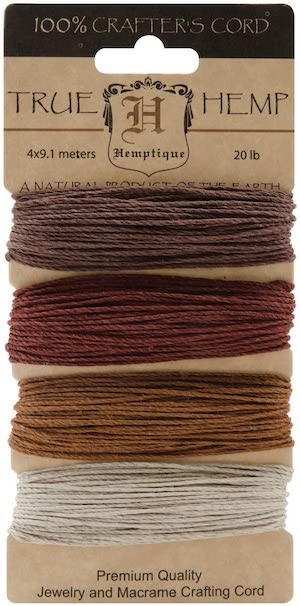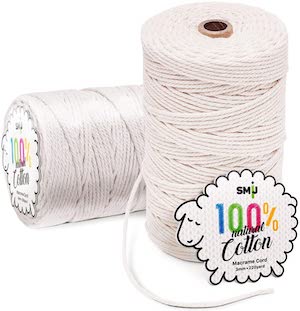Macrame is a versatile craft that allows you to create a range of projects, from fashion accessories, decorative arts, or even big pieces for your home like macrame hammocks and rugs.
It’s incredible that just by twisting and knotting strands of cords together, you can create so many amazing decors for your home and accessories for your collection.
Depending on the project, the macrame cords you’ll use are diverse in their composition, designs, width, etc. So it can be overwhelming for beginners who are just starting their very first macrame project.
So what is the best cord to use for macrame? The best cord for macrame varies by project, but should be made of a strong and durable material and should be braided or twisted. Texture and thickness will vary by need. Twisted or braided cotton is a popular, ideal choice.
If you don’t know what kind of cord to buy for your macrame pattern, below are our recommendations for the seven best cords to use for macrame, going from beginner-friendly to expert-level materials.
Macrame Cords – Buyer’s Guide
Each project requires a different type of macrame cord, so before you start any project, you should consider how the type of macrame cord you use can affect the result, including its look, texture, stiffness, and durability.
Below is our buyer’s guide of five things you should consider when you buy macrame cords.
Material
The material is the most important factor. It affects the overall look, strength, and durability of your project.
The most common material for macrame art that you can find in most craft stores is cotton, which is relatively inexpensive and beginner-friendly.
Thanks to its softness, cotton cords are perfect for projects like jewelry, hanging art, and other types of fashion accessories. Cotton cords are also easier to unravel if you make a mistake.
For projects that require strong and durable materials, such as a hammock or large plant holder, choose cords that are made of stronger materials like jute or nylon, which will help the piece last longer and provide greater support for heavy objects.
The materials affect the price of the cord as well. Cotton or cotton blend is normally quite inexpensive, while hemp, jute, or silk usually cost more.
The material will also affect the longevity of your product, especially its colors and durability. So if you are making heavy-duty objects like chairs or hammocks, make sure to choose a highly durable material that will last.
Composition
If you investigate the cord closely, you can see that the cord is made up of smaller strands which are twisted or braided together.
Braided cords are more structurally sound and the strands are less likely to unravel. However, they are also stiffer and thicker than twisted cords.
Twisted cords are more popular for macrame art because it will help you achieve the classic macrame look, but its strands are more likely to separate.
You should use twisted cords if your pattern has fringes in the end product since the braided cords are more difficult to comb out. If you chose to use a twisted cord, dipping the ends of the cord in clear wax can minimize the fraying while you work.
Thickness and Stiffness
Depending on the pattern, you should choose the proper thickness and stiffness of the cord.
For large scale projects like table runners or wall hangers, cords that are 5-6 mm in thickness and are relatively stiff will help the project take its proper shape.
Alternatively, for smaller projects like earrings or necklaces, smaller and leaner cords (3 mm or smaller) will create the best outcome that can complement your look without being too bulky.
Keep in mind that if you are incorporating beads or buttons in your design, the cord needs to fit through the beads as well.
Texture
The texture of your cord can add a nice touch to the overall look of your project, and it is especially important if you are making objects that will regularly touch your skin, like chairs, hammocks, or fashion accessories.
The material of your macrame cord will also decide its texture, since cotton or synthetic materials tend to be smoother and kinder for the skin, making them perfect for accessories projects.
On the other hand, natural materials like hemp or jute tend to be rougher, but they are great if you want to create rustic and long-lasting home decor pieces.
Length
Depending on how big or elaborate your project is, the pattern will call for a different amount of cord length that you need to buy before starting the project.
Always make sure to buy the correct amount of cords that the pattern requires to avoid differences in colors, textures, or thickness.
For example, if you are using multiple spools of dyed cords, make sure to buy the same dye lot (you can see the dye lot information in the packaging or product information), since different dye lots may have slight differences in colors.
7 Best Cords For Macrame
Now that we have a better idea what we’re looking for in a good cord for macrame, let’s look at some of the best options out there, ranging from beginner-friendly to slightly more advanced materials:
| Rank | Product | Details |
|---|---|---|
| 1. | XDOUS Macrame Cord | Cotton, 220yd |
| 2. | Bonnie Craft Cord | Polyolefin, 200yd |
| 3. | Tenn Well Braided Macrame Cord | Cotton blend, 165ft |
| 4. | MB Cordas Natural Macrame Cord | Cotton, 140m |
| 5. | G2PLUS Cotton Bakers Twine | Cotton, 656ft |
| 6. | Hemptique Hemp Crafter's Cord | Hemp, 36m |
| 7. | SMIJ Cotton Macramé Cord | Cotton, 220yd |
We have more on each cord below, so read on for a full review of each of these great macrame cords!
1. XKDOUS Natural Cotton Macrame Cord
Similar to the SMIJ cord, this natural cotton cord is also highly rated by avid macrame enthusiasts, thanks to its soft and smooth texture, durability, and ease of use.
This pure natural cotton is biodegradable and environmentally friendly, and it also has the perfect off-white color that complements the bohemian aesthetic.
Its composition and material are almost identical to the SMIJ cord, but it comes in a wider range of cord sizes, lengths, and colors, which accommodates almost every type of macrame project. While the smaller size is perfect for smaller tapestry art or jewelry, the bigger sized ropes would be amazing to create large rugs or hammocks.
This twisted rope fringes beautifully for patterns that call for fringe, but be careful while you work so that there is minimal fraying since the twist can unravel easily after a few knots.
Natural cotton offers strength and durability for ambitious projects, but it is also kind to beginners since it unravels easily if you make a mistake. Choose this cord if you are hoping to incorporate several colors in your design, or if you are looking for a thicker cotton rope but don’t want to compromise on quality and look.
2. Bonnie Macramé Cord
This beautifully soft and glossy cord is amazing for big projects. The material is bulky, highly durable, and not stretchy, but still flexible enough to adapt to almost any macrame design.
The cord is made up of several strands braided together, so it will not fray while you work. Its strong material and bulky composition create amazing support for heavy objects, so it would be amazing for big projects like a hammock or mirror hanger.
The cord is made of polyolefin fiber, so it will maintain its colors and shape for a long time without you having to worry about cleaning or maintenance.
Working with this material is especially easy and beginner-friendly since the cord can easily bend to any shape and design. You can also fuse the ends of the cords together using heat, so it’s super convenient when adding length to your working cord.
The only downside to this material is since the nylon has a shine to it, the end product may not have the rustic macrame aesthetic that you often see in macrame art. However, if you are looking for an inexpensive and strong cord to practice with, this cord is perfect for you!
3. Tenn Well Braided Macrame Cord
This braided natural cotton and polyester blend cord is another great option for those who love the matte, natural look of cotton for their macrame projects.
The eight-strand braid composition makes the rope more secure and less likely to fray, so it’s friendlier to beginners. The braided look also adds depth and stiffness to the final design, which is more difficult to achieve with a twisted robe.
Thanks to the blend between cotton and polyester, this Tenn Well braided cord is more durable and will hold up its form and colors for a long time.
Keep in mind that the braid makes the cord a bit thicker and harder to maneuver, and the product would have a more structured look. So it would work best to make plant hangers, tapestries, or rugs.
If your project calls for fringe, the strands can be combed out but they will take a wavy, textured shape, unlike twisted ropes which fringe easily. Overall, this cord is easy to work with and can adapt to most macrame patterns, but not the best option if you want to create fringes in your project.
4. MB Cordas Natural Cotton Macrame Cord
This single twisted cotton rope is perfect if your pattern calls for fringe, as it unravels easily with a wide comb. The 3 mm width and single twist design also give the end product a soft, bohemian look, which is perfect for decorative projects.
However, since this single twisted rope can fray easily, it is a bit more difficult to work with if you are a complete novice. You should seal the ends with clear wax while you work and comb out the wax once you are ready to create the fringes.
The end product would have a delicate, flowy look that will add a soft touch to your home.
The MB Cordas is made of natural cotton, great material to absorb dye if your design calls for different colors. One thing to note is that the cotton will slightly oxidize once it is wet. So you will need to dye the whole spool to avoid the colors looking odd and uneven in your finished product.
Overall, this is a high-quality cotton cord that requires some macrame skills to maneuver, but the result will have a sleek, beautiful bohemian aesthetic that’s definitely worth the invested time and effort.
5. Cotton Bakers Twine
This cord, although made of pure natural cotton, mimics the look of jute twine that gives your project a sturdy, rugged look.
Although the diameter of the cord is only 2 mm, this twine is composed of 12 strands of cotton twisted together. So it is quite thick and durable, which would work better for designs that need to support heavy weight.
The rough, rustic look of this twine is perfect to make decor items that add a nice, soft touch to the farmhouse chic aesthetic.
Jute twine can often be used in gardening or crafting, as the thin twine breaks easily and is difficult to be knotted. This cotton twine is a great substitute if you love the look of jute twine for your macrame project.
If you are a beginner to the art of macrame, we don’t recommend using this cord, since it is quite stiff with a tight twist that’s a bit more difficult to work with. This material would be perfect to make plant hangers or market bags since it can support quite a bit of weight.
The fuzzy twine adds a bit of texture to the final design, which can be a nice touch to add depth to the end product.
6. Hemptique Hemp Cord
Although hemp is not the first material that most people think of when they think about macrame art, it is a material worth experimenting with when you’ve become skilled at macrame.
This cord is on the thinner side, so it cannot be used to make bigger pieces, but it’s very strong and durable to create small plant hangers, pot plant huggers, or hanging shelves.
The cord is intricately woven so it will hold knots beautifully without stretching out. However, despite its thin diameter, it is a bit stiffer than cotton cords, so it will require a bit more effort to knot when you create macrame designs.
Hemp is a natural, biodegradable material that’s environmentally friendly. Your end product will have a rustic chic look that can blend perfectly with earthly, green homes.
We recommend experimenting with this material once you’re already familiar with macrame techniques and cotton ropes, since it will allow you to branch out with new designs and create more interesting projects.
Hemp is also a bit more expensive than other macrame materials, and it’s also harder to unravel if you make a mistake, so make sure that you are certain of your skills and design before starting a macrame project with hemp.
7. SMIJ Natural Cotton Macramé Rope
This natural cotton rope is a great material for macrame projects. It is soft, smooth, highly durable, and aesthetically pleasing.
This particular product is a 3 mm twisted rope consisting of 4 strands, which is thin enough to create intricate macrame designs but also strong enough to support weight, especially if you want to make plant holders or hanging shelves.
If you are a beginner, choosing a cotton robe for your first project would be a wise choice, but pay attention as the twisted rope can fray easily.
Before you start, you can dip the ends of your cords in clear wax to prevent it from fraying, and comb out the wax once your project is finished.
We recommend this cord because not only is it super easy to work with, especially if you are a beginner, it also creates stunning macrame products that are Pinterest-worthy. The cotton cord is also super easy to undo if you make a mistake.
Even better, this cord is made of environmentally friendly natural cotton, which is odorless and tintless. This cord can be used in a versatile range of designs, but we recommend bohemian-inspired looks since its color and texture is perfect for this aesthetic.
Up Next: How To Tie A Secure Knot For A Bracelet – 5 Ways

